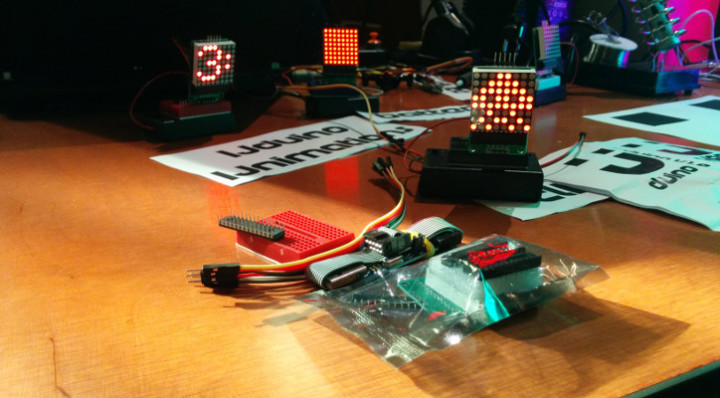€10 IJduino Kit Teaches People Computer Basics
August 20, 2015
on
on

“First we looked at electronic trinkets”, says Anne Jan Brouwer from IJhack, a hacker collective geared toward helping people understand technology. “but those you just solder together and there isn’t much else you can do with them after that.” Preparing for their first workshop the IJhack members were looking for a project to offer to participants.
“We considered an assembly kit of a screen, a chip and a button. A nice soldering project but not much more”, says Brouwer. When they could not find a satisfactory kit on the market, they developed their own.
“We wanted an Arduino type thing. Because it is easier to understand what the different components do when there are fewer of them, we started stripping off everything you don’t need right up to the point it would really break down. That’s how we arrived at our first kit, the IJduino.”
The IJduino comes in 14 parts including a 8×8 LED grid, a mini breadboard, an Atmega328, a battery holder, a button and, optionally, an Atmel In-System Programmer.
The entire instruction manual fits on a double-printed A4 paper, says Brouwer enthusiastically. It is an indication of the simplicity of the project. In 12 steps you have built your own computer.
IJhack
IJhack was supposed to be an Amsterdam-based hackerspace. “We want to become an open space for people who are interested in tinkering with technology but have no idea where to begin”, says Brouwer. “There are other hackerspaces in Amsterdam such as LAG and TechInc but they are more for nerds by nerds. We’d like to be open to everyone. Ideally our space will be a shop where people can buy stuff that doesn’t work. They have to put it together at home or during the workshops we host in the space.”
But IJhack, which takes its name from the IJ, a body of water central to the city of Amsterdam, isn’t an official hackerspace yet. “We gathered in a bar each month to discuss how to set up the space but there wasn’t much progress and it got a bit boring. So we decided to focus on nice things, like organizing a workshop. And if you’re hosting a workshop you need an end product, a goal, something.” And so the IJduino was born.
flappIJbird
At the first workshop held September last year, 16 participants took part in building the IJduino and creating animations for its 8×8 LED grid. “At the start most of them said ‘I can’t do this’ but at the end of the evening all of them had soldered a computer and we had 10 new animations”, Brouwer recalls.
People were enthusiastic and we gave a few more workshops. Around that time at a party someone said they wanted to code a game for the IJduino and two nights later we had flappIJbird. We’d already ported some open source games, such as Snake which is called pIJthon because it does not have an IJ in it and IJpong. To play tetrIJs you need an IJduino with two screens.”
€10 computer
IJduino’s components add up to around €10 but the kit is sold for €20. “We calculate the price by charging twice the cost of the cheapest Chinese. It’s a ‘buy one – sponsor one’ principle, that way we always have kits available for the next workshop or event. And for that price it’s still cheaper than if you would buy it in the Netherlands.
Someday IJhack will become an actual hackerspace, thinks Brouwer. Until then its members hang out in the other hackerspaces and continue to develop IJduino. “We’re working on integrating a WiFi module but there are still a few snags. It is neither easy nor foolproof at the moment so we need to come up with middleware to improve it.”
Read full article
Hide full article


Discussion (0 comments)